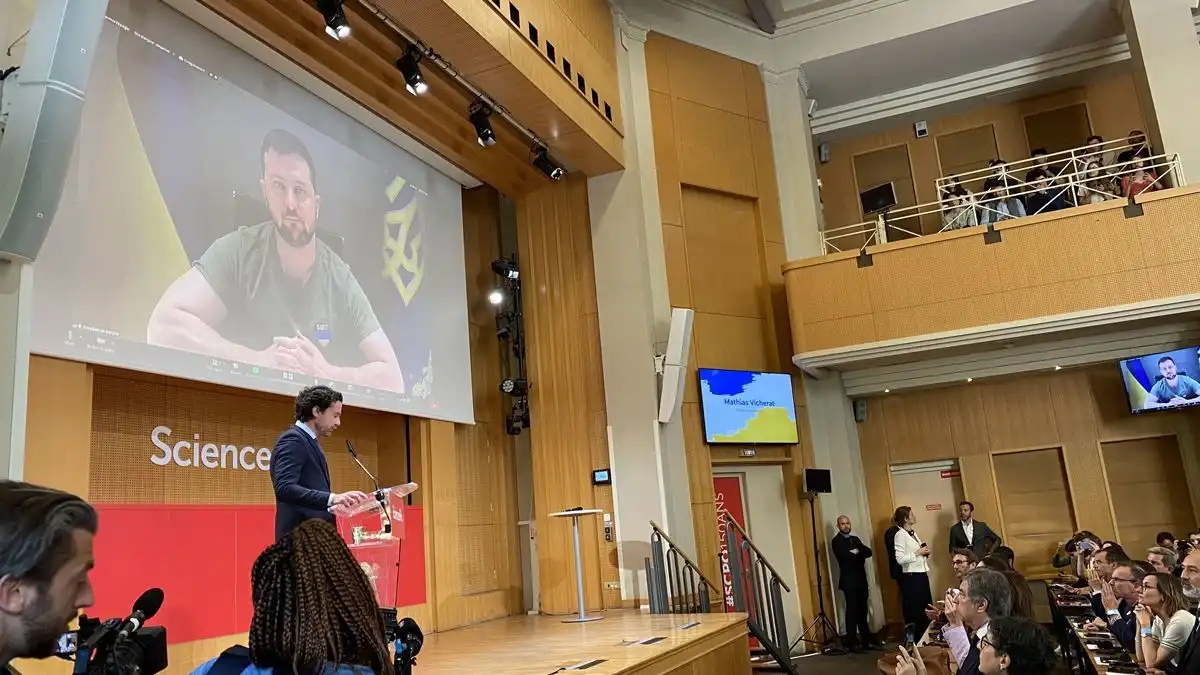Home>Behind the scenes at the “60 Minutes with Volodymyr Zelensky” conference
13.05.2022
Behind the scenes at the “60 Minutes with Volodymyr Zelensky” conference
Breaking news: in less than one week, on May 11, 2022, the Ukrainian president Volodymyr Zelensky would speak with French students via videoconference in the Boutmy Amphitheater at Sciences Po. A major event, because it would be the first time a country at war has chosen to dialogue with young Europeans.
The organizers of the conference mobilized all their teams, from senior management to our Paris School of International Affairs to the communications department to the security and logistics teams at 27 rue Saint Guillaume. The conference relied entirely on the Institute for Skills and Innovation’s resources and audiovisual teams. There were multiple challenges, including establishing a link with Kiev and figuring out which videoconferencing system they could use. They also had to manage three interpreters, one in Ukraine for the president, translating French into Ukrainian , and two others in France, translating into English and French for both local and distant audiences. The conference would be translated simultaneously in English and French in the Boutmy Amphitheater, then diffused in two other amphitheaters at 27 rue Saint Guillaume and in the main hall. The two live streams, one with simultaneous translation in French and the other in English, would be broadcast and retransmitted in amphitheaters on our regional campus as well as numerous other universities in France. It would also be necessary to install additional video cameras so that the Ukrainian president could see the audience from different angles.
Tuesday May 10th was dedicated to technical issues and set up, as well as a tests with Kyiv. At 9:00 am, there was a briefing with the team. “Tomorrow you are going to deal with lighting, record images and sound, and produce a program that will be followed by tens of thousands of people.” The team became aware of the importance of the event. One team member summed it up: “tomorrow we work for history] !”
The technical news from Kyiv was reassuring. Like us, they were using Zoom, which has integrated functions for managing interpreters. At precisely 5pm, the link with Kyiv would be established, an emotional moment when President Zelensky’s office would appear on the Boutmy Amphitheater screen in front of the Ukrainian flag, with a member of his team sitting in combat fatigues. The interpreter, connected from another site in Ukraine, would also be present. There would be just one adjustment to make: adding the Ukrainian channel to those already available for interpreters in our Zoom meetings.
On the digital front, the IT department was ready, keeping an eye on our network access. The Zoom teams, for their part, added extra protection to make the videoconference ultra-secure.
On the morning of May 11, there were non-stop installations and tests with the two booths and the interpreters. Two hours before the event, there was news: BFM TV would broadcast the entire conference live. A special transmission was set up. One hour before the event, students from the various partner universities who would interact with Volodymyr Zelensky were coached: “don’t look at the amphitheater screen or at the audience, but at the control screen located on the left side of the amphitheater. Just above there was a video camera that would make it possible for them to dialogue with the president”.
Five minutes before the conference began, a Ukrainian flag appeared on Zoom. It was the signal they were waiting for. Kyiv was ready. Mathias Vicherat could welcome Volodymyr Zelensky. 80,000 people followed the conference on the Sciences Po YouTube channel.
Find out more
Highlights from the exchange between Volodymyr Zelensky and French students (FR).
